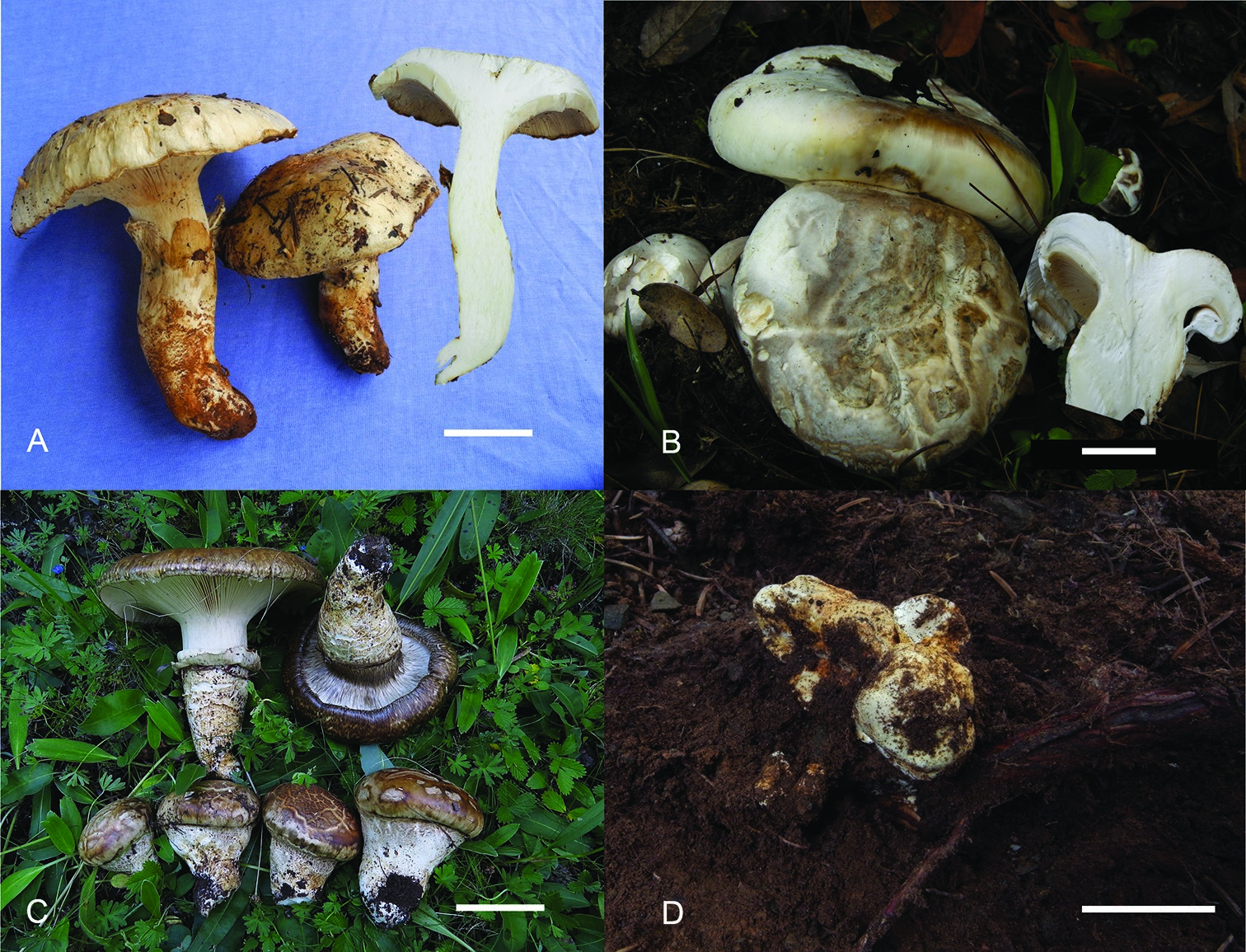 181
181
Catathelasma subalpinum Z. W. Ge, sp. nov. 2020
MycoBank No: 830872
Holotype China. Yunnan Province: Lijiang, Ninglang, Xichuan Xiang, 14 July, 2010, J. Qin 65 (Holotype: HKAS 67751).
Morphological description
Pileus 3.5–15 cm broad, hemispherical at early stage, expanding to broadly convex with age, shallowly depressed at centre, white to dirty white at first, then greyish-white (1B1) to greyish-yellow (4C4), grey (8B1) when mature, with incurved margin, viscid when wet, sometimes irregularly cracked. Lamellae slightly decurrent, crowded, whitish, thick, 8 mm in height, with 2–3 tiers of lamellulae, with smooth edge, covered by a white, well developed, thick membranous veil in early stage. Stipe 11–14 × 3–5.5 cm, fusiform, attenuated downwards, whitish to yellowish-white, firm, with double annulus in which the lower annulus is flimsy and the upper one is membranous, thick, around 2.5 cm away from the stipe apex; with white inner side and greyish-yellow outer side. Context white in pileus and stipe, not changing colour when cut, 3.5 cm thick in pileus; smell and taste farinaceous. Spore print white.
Basidiospores [43/2/2] (9) 10–12 × 5–6 μm (mean 10.7 ± 0.8 × 5.4 ± 0.5 μm), Q = (1.67) 1.80–2.20 (2.40), Qm = 1.99 ± 0.18, subcylindrical in frontal view, subcylindrical to somewhat inequilateral in side view, hyaline in KOH, amyloid, smooth, thin-walled. Basidia 35–45 × 8–9 μm, narrowly clavate, 4-spored; sterigmata up to 5 μm long. Pleurocystidia none. Cheilocystidia basidiole-like, hyalinous. Lamella trama subregular, somewhat bilateral towards lamella edge, made up of more or less parallel to interwoven hyphae. Oleiferous hyphae present in both lamella and pileus trama. Pileipellis a thick ixolattice (500–650 μm thick) of 1.5–10 μm wide hyphae which gelatinise and collapse, occasionally interspersed with oleiferous hyphae; the layer grading gradually into pileal trama. Clamp connections abundant in all tissues.
Habitat:
Distribution: Known from Yunnan Province, south-western China
GenBank Accession: ITS, MK909099; LSU, MK909121.
Notes: Catathelasma subalpinum is closely related to C. laorentou, which is also from south-western China. However, C. subalpinum differs by its higher elevation distribution and its association with Pinus densata, while C. laorentou has pale yellow to greyish-yellow basidiomes, associations with P. yunnanensis and Keteleeria evelyniana forests and is comparatively more common than C. subalpinum. Besides, C. subalpinum has much fewer oleiferous hyphae in the pileipellis. In addition, phylogenetic trees, reconstructed from ITS, 28S, TEF1 and concatenated ITS-LSU-TEF1, support the separation of C. subalpinum from C. laorentou.
Reference: Zai-Wei Ge1,2, Jian-Yun Wu1,2, Yan-Jia Hao3 , et al.
Figure 2 B Catathelasma subalpinum (HKAS 67751)

